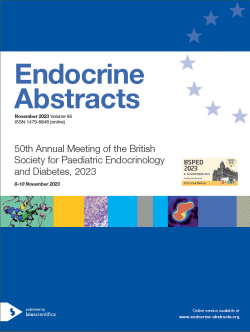
50th Annual Meeting of the British Society for Paediatric Endocrinology and Diabetes
Manchester,
UK
08 Nov 2023 - 10 Nov 2023

Poster Presentations
Adrenal 1
ea0095p1 | Adrenal 1 | BSPED2023
Premature adrenarche and cardiometabolic risk – characterisation of a pilot cohort
Said Wogud Ben , Cooper Lucy , Krone Ruth , Thangaratinam Shakila , Arlt Wiebke , Idkowiak Jan
ea0095p2 | Adrenal 1 | BSPED2023
Antenatal exposure to steroids, should we worry about neonatal adrenal suppression?
Ahmed Khubaib , Piaggio Umberto
ea0095p3 | Adrenal 1 | BSPED2023
Case series of non-classical congenital adrenal hyperplasia in childhood
Hickingbotham Hannah , Olivier Jessica , Ramaswamy Priya , Chowdhury Nazma , Wei Christina
ea0095p4 | Adrenal 1 | BSPED2023
Patient education for management of sick day episodes in adrenal insufficiency: A systematic review of published literature on structured education programs
Bradford Anna , Mason A , Wong SC
ea0095p5 | Adrenal 1 | BSPED2023
Retrospective review of patients with 21-hydroxylase deficiency (21OHD) Congenital adrenal hyperplasia (CAH) in a tertiary children’s hospital
Riches Katherine , Abey Rose , Denvir Louise , Law James , Sachdev Pooja
ea0095p6 | Adrenal 1 | BSPED2023
Bone mineral density in children with congenital adrenal hyperplasia presenting to tertiary care hospital from LMIC
Karishma Rahak , Mohsina Noor Ibrahim , Versha Rani Rai , Maira Riaz , Roshia Parveen , Heeranand Rathore
ea0095p7 | Adrenal 1 | BSPED2023
CortiCit: Development of a hydrocortisone intramuscular injection kit for adrenal crisis
James K Lynette , Burrows Ross , Foley Louise , Hallam Angela , Morgan Amelia Huw , HigmanJames Delyth , Pryce Rebekah , Talbot Catherine , Rees D Aled
ea0095p8 | Adrenal 1 | BSPED2023
When management becomes the source of my sorrow! (prolonged steroids’ side effects and adrenal insufficiency from the patient’s perspective)
ea0095p9 | Adrenal 1 | BSPED2023
First case recognized as autoimmune polyglandular syndrome type 2 with double seronegative myasthenia gravis – A case report-from Pakistan
Riaz Maira , Rani Versha , Ibrahim Mohsina , Khoso Zubair



